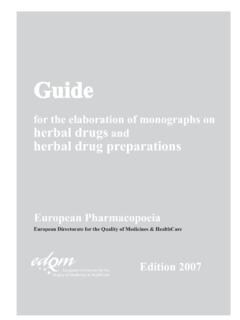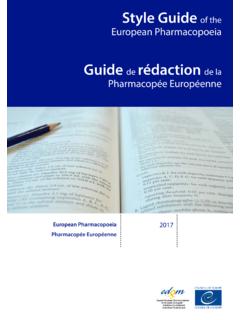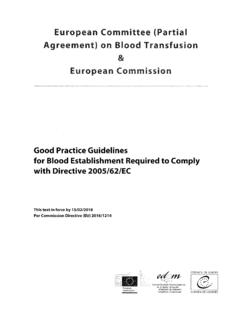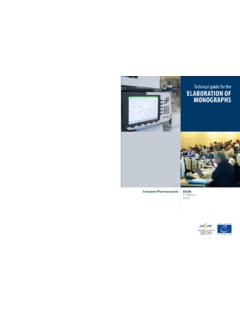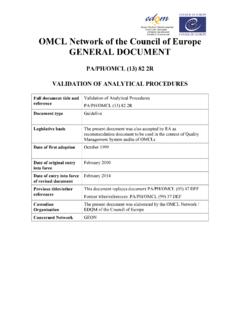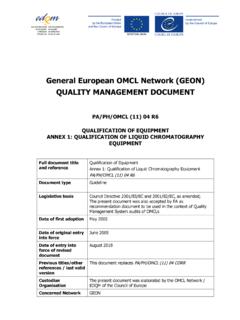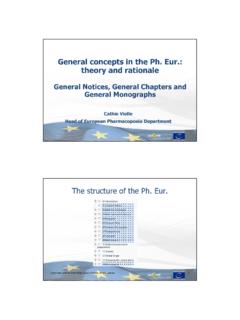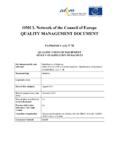Transcription of Technical Guide - EDQM - European Directorate for the ...
1 Technical Guidefor the elaboration of monographs European PharmacopoeiaEuropean Directorate for the Quality of Medicines & HealthCare 6th Edition - 2011 Council of Europe, 67075 Strasbourg Cedex, France - 2011 All rights reservedMaking copies of this fi le for commercial purposes or posting this fi le on a web site that is open to public consultation is strictly Technical Guide FOR THE ELABORATION OF monographs 6th Edition 2011 CONTENTS 1. INTRODUCTION .. 6 PURPOSE OF THE Guide .. 6 TEST PROCEDURES .. 6 EQUIPMENT .. 7 QUANTITIES .. 7 REAGENTS .. 9 COMMERCIAL NAMES .. 9 REFERENCE STANDARDS .. 10 2. MONOGRAPH ON A SUBSTANCE FOR PHARMACEUTICAL USE .. 10 DEFINITION .. 11 Combinations .. 12 Content .. 12 CHARACTERS .. 14 Appearance .. 14 Taste .. 15 Odour.
2 15 Solubility .. 15 Stability factors .. 15 Hygroscopicity .. 15 Solid-state properties .. 16 Other characteristics .. 16 Behaviour in solution .. 16 IDENTIFICATION .. 17 General .. 17 Methods requiring complex instrumentation .. 18 Other methods .. 18 Infrared absorption spectrophotometry .. 18 Salts of organic acids or bases .. 18 Chemically related substances .. 18 Polymorphism .. 19 Optical isomers .. 19 Ultraviolet and visible absorption spectrophotometry .. 19 Melting point, freezing point and boiling point .. 20 Specific optical rotation .. 21 Thin-layer chromatography .. 21 Gas chromatography and liquid chromatography .. 21 Chemical reactions .. 22 22 General .. 22 Titles .. 22 Solution S .. 23 Appearance of solution .. 24 Clarity and degree of opalescence.
3 24 4 Degree of coloration .. 25 pH and Acidity or alkalinity .. 25 Optical rotation .. 27 Absorption spectrophotometry (ultraviolet and visible) .. 27 Related 28 Thin-layer chromatography (TLC) .. 32 Liquid chromatography (LC) .. 33 Gas-liquid chromatography (GC) .. 37 Capillary electrophoresis (CE) .. 38 Readily carbonisable substances .. 39 Foreign anions and/or cations .. 39 Heavy metals .. 40 Loss on drying .. 41 Thermogravimetry ( ) .. 42 Semi-micro determination of water (Karl Fischer ).. 42 Micro determination of water ( ) .. 42 Gas chromatographic determination of water .. 43 Determination of water by distillation ( ) .. 43 Sulfated ash ( ) .. 43 Residue on evaporation .. 43 Residual solvents .. 43 ASSAY .. 44 Ultraviolet and visible spectrophotometry.
4 44 Direct measurement .. 44 Measurement after a colour reaction .. 45 Volumetric analysis .. 45 Chromatography .. 46 Determination of nitrogen by sulfuric acid digestion (semi-micro method) .. 46 STORAGE .. 46 LABELLING .. 47 IMPURITIES .. 47 FUNCTIONALITY-RELATED CHARACTERISTICS .. 47 3. ANALYTICAL VALIDATION .. 48 DEFINITIONS AND TERMINOLOGY .. 48 Introduction .. 48 Types of analytical procedures to be validated .. 48 Validation characteristics and requirements .. 49 50 METHODOLOGY .. 52 Introduction .. 52 Specificity .. 53 Identification .. 53 Assays and impurity tests .. 53 Linearity .. 54 Range .. 54 Accuracy .. 55 Assay .. 55 5 Impurities (quantification) .. 56 Recommended data .. 56 Precision .. 56 Repeatability .. 56 Intermediate 56 Reproducibility.
5 56 Recommended data .. 57 Detection limit .. 57 Based on visual evaluation .. 57 Based on signal-to-noise ratio .. 57 Based on the standard deviation of the response and the slope .. 57 Recommended data .. 58 Quantitation limit .. 58 Based on visual evaluation .. 58 Based on signal-to-noise ratio .. 58 Based on the standard deviation of the response and the slope .. 58 Recommended data .. 59 59 System suitability testing .. 59 SPECIFIC APPLICATION TO METHODS USED IN THE PHARMACOPOEIA .. 60 Optical rotation ( ) .. 60 Introduction .. 60 Identification .. 60 Tests .. 60 Assay .. 61 Ultraviolet spectrophotometry ( ) .. 61 Identification .. 61 Limit test .. 61 Assay .. 61 Non-instrumental limit tests .. 61 Appearance of solution ( and ) .. 61 Acidity or alkalinity.
6 62 Limit tests for anions/cations ( ) .. 62 Atomic absorption spectrometry ( ) .. 63 Specificity .. 63 Calibration .. 63 Matrix effects .. 64 Detection and quantification limit (based on the standard deviation of the blank) .. 64 Separation techniques .. 65 Thin-layer chromatography ( ) .. 65 Liquid chromatography ( ) .. 66 Gas chromatography ( ) .. 67 Semi-micro determination of water ( ) .. 69 Volumetric titrations ( ; ; ) .. 69 Peptide identification by nuclear magnetic resonance spectrometry ( ) .. 72 6 Technical Guide FOR THE ELABORATION OF monographs 1. INTRODUCTION PURPOSE OF THE Guide This document is a guidance for the authors of monographs and also a means of communicating to the users of the European Pharmacopoeia, especially industry, licensing authorities and official medicines control laboratories, the principles for the elaboration of monographs .
7 Since the principles applied and guidance given for the elaboration of monographs should be the same as those applied by licensing authorities, the Technical Guide may also serve as a guideline in the elaboration of specifications intended for inclusion in licensing applications. It is necessary to bear in mind that a monograph will be a mandatory standard and must be applicable in licensing procedures in all Member States of the Convention on the Elaboration of a European Pharmacopoeia. The procedures for the tests and assays in the individual monographs must therefore have been validated according to the current practice at the time of their elaboration. TEST PROCEDURES The methods chosen for the identification tests, purity tests and assay(s) constituting the bulk of a pharmacopoeial monograph are preferably those already described and utilised in the European Pharmacopoeia.
8 In this context, the author of a monograph is referred not only to the General Methods of the Ph. Eur. but also to published monographs on similar materials. The above considerations aim at ensuring a reasonable degree of harmonisation within the Pharmacopoeia and they only apply in cases where the methods are found to be adequate for the specific purposes. However, due attention is also to be paid to the development of new methods that offer significant improvements in terms of sensitivity, precision, accuracy or discriminating power (selectivity). Methods included in monographs must be validated as described in the section on analytical validation and other relevant specific sections of this Guide . Validation reports are provided to the EDQM but are not published or otherwise provided to users.
9 The test procedures included in a monograph should be verified in 2 or more laboratories and the laboratory reports on this verification should be provided to the EDQM to ensure future traceability. The instructions describing any method of analysis cover all factors that can influence the results and that are deemed essential to enable an experienced analyst working according to acknowledged laboratory practices, yet without necessarily having any prior knowledge of the investigation in question, to perform the analysis. Variations in the description of similar methods are to be avoided. 7 If an analytical procedure is, or may be, expected to be used generally or if it requires a lengthy description and is used more than once, it may be proposed for inclusion in the general chapters of the Pharmacopoeia, to be referred to in the individual monographs .
10 The methods are prescribed on the scale conventionally applied in the Pharmacopoeia except in cases where for reasons of availability of the material to be analysed, or because of its toxicity or its cost, work on a small scale would be advantageous. EQUIPMENT If the equipment utilised for a method of analysis is not generally available in the States party to the European Pharmacopoeia Convention, it must be possible to have it constructed according to its description in the Pharmacopoeia. QUANTITIES In prescribing the quantities, masses and volumes, of substances, reagents, and solvents to be taken for identifications, tests and assays, it is the practice of the Pharmacopoeia to indicate in detail the precision with which they are to be measured (see General Notices).
